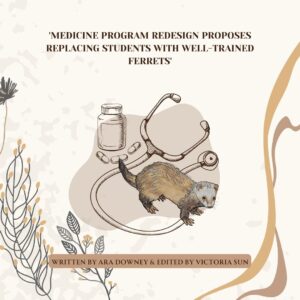
by NICK CHANG
At one point or another, I think we have all heard an overly ambitious first year declare they want to be a neurosurgeon. Some of us were that overly ambitious first year (guilty). To quote Christina Yang on Grey’s Anatomy “Surgery’s hot. It’s the marines. It’s macho. It’s hostile. It’s hardcore”. While you won’t hear that kind of crap from anyone but the most zealous of SurgSoc cultists, it’s true there’s a special something about surgery that a certain kind of person finds attractive. International cross-sectional data seems to suggest that these certain kinds of people are more likely to value social prestige and financial remuneration, and less likely to be lifestyle oriented, but that is neither here nor there. Today we’ll be unpacking the most recent info from the Royal Australian College of Surgeons: what does it take to be selected for surgical training, who makes it, when do they make it, is it worth it?
Surgical Education & Training:
RACS is the centralized authoritative body for the training and accreditation of surgeons in Australia and New Zealand. They offer training pathways, termed Surgical Education and Training (SET) programs, in nine surgical specialties: cardiothoracics, general, neurosurgery, orthopaedics, otolaryngology, paediatric surgery, plastics, urology and vascular. Unlike some other specialties, like anaesthetics, all aspiring surgical trainees apply to RACS, who then allocate successful candidates to their training locations – i.e. you do not apply to hospitals but instead straight to the college.
Before being accepted to the SET and becoming a registrar, you must have completed internship and residency (and for many specialities, a number of years as an unaccredited registrar). The exact selection requirements differ depending on the specialty but in general consist of a structured CV (scored on the basis of higher degrees, time spent in the specialty, published papers, conference presentations and skill courses), reference reports from surgeons and other staff with whom you’ve worked and an interview process. Most specialty boards now also mandate successful completion of the General Surgical Sciences Examination before application. Once you’ve been accepted as a registrar, there is between 4 and 7 years of training before sitting the fellowship exam and becoming a fellow of RACS. It is becoming increasingly necessary to then undergo further subspecialty training or international fellowship training prior to being offered a job as a consultant surgeon.
The Numbers:
Now that we’ve gone over a brief overview of the training pathway, what do the numbers say about surgical training? To answer this question, we turn to the Activities Report 2017 from RACS published this year.
First of all, how many people actually make the SET each year? In 2017, 890 applications were made to RACS which resulted in 256 offers (28.8%). However, there is enormous variation between specialties with respect to the number of trainees they accept each year. For example, general surgery accepted 105 new registrars Australia wide in 2017, while cardiothoracics and neurosurgery accepted only 8 each. In fact, not a single NSW applicant was accepted for neurosurgical training in 2017 and word on the street is that only one was accepted this year (maybe broaden your horizons if you’ve only considered neurosurgery). Due to small samples sizes and significant variation year to year, meaningful numbers can’t be provided concerning the proportion of successful applicants for each specialty. Suffice to say they are low.
What do the numbers say about women in surgery? In 2017, the number of female SET applicants increased by 10% to almost one third of all applications. Women composed over 30% of successful applications in 2017, representing a 6% increase since 2016. Whilst this is encouraging, unfortunately, some specialties remain dominated by male applicants. In 2016, neurosurgery did not accept any female candidates, while orthopaedics accepted only 3 women out of their 55 successful applicants. The best performing surgical specialty with respect to gender balance in 2017 was paediatric surgery with 4 male applicants and 3 female applicants successful.
When can we finally be finished training? Unfortunately, this isn’t very easy to tease out given the data that RACS hands out. If you go ahead and add up all the years of training and exams you’ll be expected to complete before becoming a fellow you’ll probably arrive at a number in the early to mid-thirties. Gratifyingly, this actually appears to be possible. In 2017, there were 205 RACS fellows under the age of 35. As you would expect, these fellows were overwhelmingly specialized in general and orthopaedic surgery, 93 and 43 respectively. However, every specialty had some fellows practising under the age of 35, including 4 neurosurgeons and 2 cardiothoracic surgeons.
Final Notes:
In the face of all those daunting statistics, I’ll leave you with some advice that I’ve found really valuable over the last couple of years.
From one of the recently appointed female orthopaedic registrars: never give up – “even if only 1% of those who set out to be surgeons make it, there still needs to be people in that 1%, so if you work harder and do better than the other 99% it will include you”.
From an aspiring ENT surgeon who published 16 first author papers in medical oncology before changing his mind – “it’s important to have goals; they give you direction and motivate you. Don’t pigeon hole yourself though, you’ve got to have an open mind to specialties you would never consider and be ready to abandon sunk costs”.














































































































Lmao is it worth it tho 🤔🤔
[…] thing before we leave you (sadly): check this article if you feel compelled to find out a bit more about what later surgical training […]